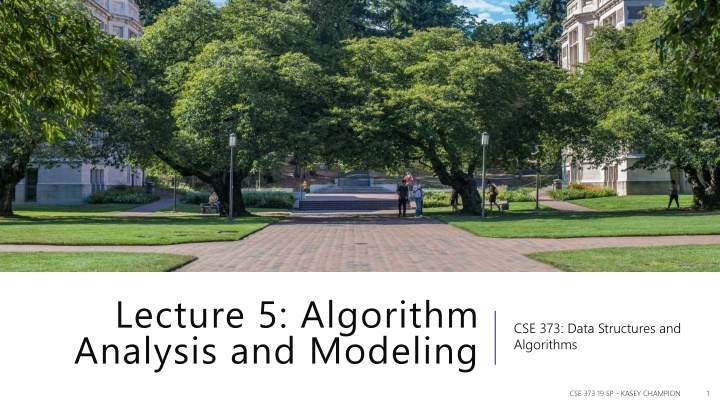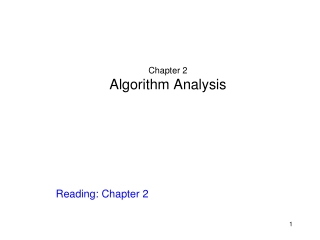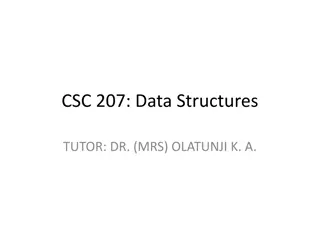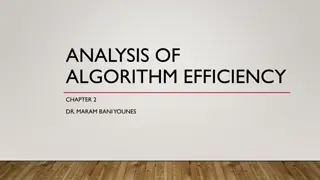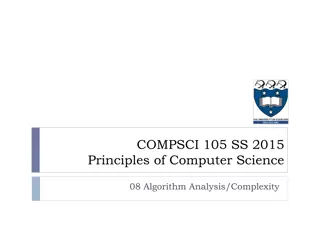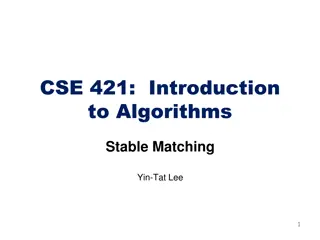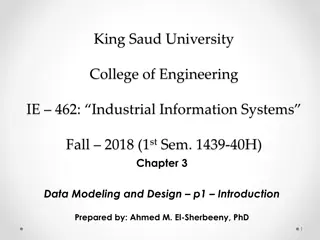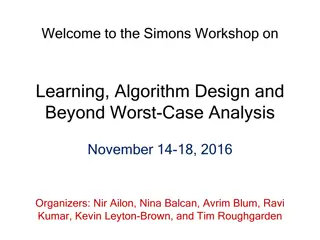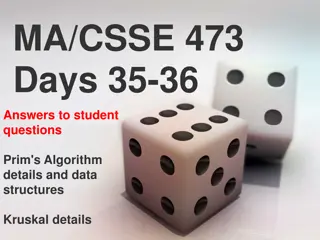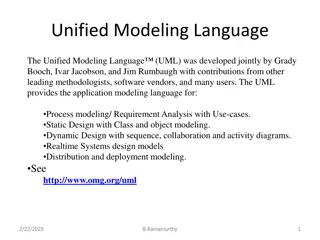Algorithm Analysis and Modeling in Data Structures
Process of mathematically representing runtime of algorithms in relation to number of inputs, focusing on growth functions, asymptotic analysis, and comparison of algorithm efficiencies. Learn about modeling worst case runtimes, understanding Big O notation, and analyzing code performance based on input sizes.
Download Presentation

Please find below an Image/Link to download the presentation.
The content on the website is provided AS IS for your information and personal use only. It may not be sold, licensed, or shared on other websites without obtaining consent from the author.If you encounter any issues during the download, it is possible that the publisher has removed the file from their server.
You are allowed to download the files provided on this website for personal or commercial use, subject to the condition that they are used lawfully. All files are the property of their respective owners.
The content on the website is provided AS IS for your information and personal use only. It may not be sold, licensed, or shared on other websites without obtaining consent from the author.
E N D
Presentation Transcript
Lecture 5: Algorithm Analysis and Modeling CSE 373: Data Structures and Algorithms CSE 373 19 SP - KASEY CHAMPION 1
5 Minutes Warm Up Approach Approach -> start with basic operations, work inside out for control structures - Each basic operation = +1 - Conditionals = worst case test operations + branch - Loop = iterations (loop body) Construct a mathematical function modeling the worst case runtime for the following functions public void mystery1(ArrayList<String> list) { public void mystery2(ArrayList<String> list) { for (int i = 0; i < 3000; i++) { for (int i = 0; i < list.size(); i++) { for (int j = 0; j < 1000; j++) { for (int j = 0; j < list.size(); j++) { System.out.println(list.get(0)); +1 n(1) int index = (i + j) % list.size(); +4 n(n(1)) System.out.println(list.get(index)); +2 1000(6) } } } Possible answer T(n) = n2 3000(1000(6) + n(1)) for (int j = 0; j < list.size(); j++) { } System.out.println( :) ); +1 } n(1) Socrative: Socrative: www.socrative.com Room Name: CSE373 Please enter your name as: Last, First } } Possible answer T(n) = 3000 (6000 + n) CSE 373 SP 18 - KASEY CHAMPION 2
Adminstrivia HW 1 Due Tonight at 11:59pm HW 2 goes live Today Please fill out class survey Read Pair Programming Doc if you haven t! CSE 373 SP 18 - KASEY CHAMPION 3
Why dont we care about exact constants? Not enough information to compute precise constants Depends on too many factors (underlying hardware, background processes, temperature etc ) We really care about the growth of the function Big O CSE 373 SP 18 - KASEY CHAMPION 4
Comparing Functions CSE 373 SP 18 - KASEY CHAMPION 5
Asymptotic Analysis asymptotic analysis asymptotic analysis the process of mathematically representing runtime of a algorithm in relation to the number of inputs and how that relationship changes as the number of inputs grow Two step process Two step process 1. 1. Model Model the process of mathematically representing how many operations a piece of code will run in relation to the number of inputs n 2. 2. Analyze Analyze compare runtime/input relationship across multiple algorithms 1. Graph the model of your code where x = number of inputs and y = runtime 2. For which inputs will one perform better than the other? CSE 373 SP 18 - KASEY CHAMPION 6
Function growth Imagine you have three possible algorithms to choose between. Each has already been reduced to its mathematical model ? = ?2 ? ? = 4? ? ? = ? ? ? ? ? ? ? ? ? ? The growth rate for f(n) and g(n) looks very different for small numbers of input but since both are linear eventually look similar at large input sizes whereas h(n) has a distinctly different growth rate But for very small input values h(n) actually has a slower growth rate than either f(n) or g(n) CSE 373 SP 18 - KASEY CHAMPION 7
Review: Complexity Classes complexity class complexity class a category of algorithm efficiency based on the algorithm s relationship to the input size N Class Class Big O Big O If you double N If you double N Example algorithm Example algorithm constant O(1) unchanged Add to front of linked list Binary search logarithmic O(log2n) O(n) Increases slightly linear doubles Sequential search log-linear O(nlog2n) Slightly more than doubles quadruples Merge sort quadratic O(n2) Nested loops traversing a 2D array Triple nested loop cubic O(n3) Multiplies by 8 polynomial O(nc) exponential O(cn) Multiplies drastically http://bigocheatsheet.com/ CSE 143 AU 18 HUNTER SCHAFER 8
Moving from Model to Complexity Class Say an algorithm runs 0.4N 17 17 statements 17 is quickly dwarfed in the context of thousands of inputs We ignore constants like 25 because they are tiny next to N N3 is so powerful it dominates the overall runtime O(N3) 0.4N3 3 + 25N + 25N2 2 + 8N + + 8N + Consider the runtime when N is extremely large Lower order terms don t matter delete them. Multiplying by constant factors has little effect on growth rate Highest order term dominates the overall rate of change Gives us a simplified big-O 10?log? + 3? ?(?log?) 5?2log? + 13?3 ? ?3 20?loglog? + 2 ?log? ?(?log?) ?(8?) 23? CSE 373 SP 18 - KASEY CHAMPION 9
Definition: Big-O Why ?0? We wanted to find an upper bound on our algorithm s running time, but -We don t want to care about constant factors. -We only care about what happens as ? gets large. Big-O ?(?)is?(? ? )if there exist positive constants ?,?0 such that for all? ?0, ? ? ? ? ? Why ?? We also say that ? ? dominates ?(?) O(g(n)) O(g(n)) is the family or set of all functions that are dominated by g(n) CSE 332 SU 18 - ROBBIE WEBER 10
Big-O Applying Big O Definition ?(?)is?(? ? )if there exist positive constants ?,?0 such that for all? ?0, ? ? ? ? ? Show that is ? ? ? ? = 10? + 15 Apply definition term by term 10? ? ? ? ?? ? = 10 ??? ??? ?????? ?? ? 15 ? ? ? ?? ? = 15 ??? ? 1 Add up all your truths 10? + 15 10? + 15? 25? ??? ? 1 Select values for c and n0 and prove they validate the definition Take Take? = ??and and??= ? 10? 25? ??? ??? ?????? ?? ? 15 25? ??? ? 1 Thus because a c and n0 exist, f(n) is O(n) CSE 373 SP 18 - KASEY CHAMPION 11
3 Minutes Exercise: Proving Big O Demonstrate that 5n2 + 3n + 6 is dominated by n3 by finding a c and n0 that satisfy the definition of domination Big-O 5n2+ 3n + 6 5n2 + 3n2 + 6n2when n 1 5n2 + 3n2 + 6n2 = 14n2 5n2+ 3n + 6 14n2for n 1 14n2 c*n3 for c = ? n >= ? ?(?)is?(? ? )if there exist positive constants ?,?0 such that for all? ?0, ? ? ? ? ? 14 ? -> c = 14 & n >= 1 c = 14 & n >= 1 CSE 373 SP 18 - KASEY CHAMPION 12
Edge Cases True or False: 10?2+ 15? is ?(?3) It s true it fits the definition 10?2 ? ?3 ? ?? ? = 10 ??? ? 1 15? ? ?3 ? ?? ? = 15 ??? ? 1 10?2+ 15? 10?3+ 15?3 25?3 ??? ? 1 10?2+ 15? is ?(?3)because10?2+ 15? 25?3 ??? ? 1 Big-O is just an upper bound. It doesn t have to be a good upper bound If we want the best upper bound, we ll ask you for a tight ? ?2is the tight bound for this example. It is (almost always) technically correct to say your code runs in time?(?!). DO NOT TRY TO PULL THIS TRICK ON AN EXAM. Or in an interview. tight big-O bound. CSE 332 SU 18 - ROBBIE WEBER 13
Why Are We Doing This? You already intuitively understand what big-O means. Who needs a formal definition anyway? -We will. Your intuitive definition and my intuitive definition might be different. We re going to be making more subtle big-O statements in this class. -We need a mathematical definition to be sure we re on the same page. Once we have a mathematical definition, we can go back to intuitive thinking. -But when a weird edge case, or subtle statement appears, we can figure out what s correct. CSE 332 SU 18 - ROBBIE WEBER 14
3 Minutes Function comparison: exercise True True all linear functions are treated as equivalent True True False False True True quadratic will always dominate linear True True False False f(n) = n g(n) = 5n + 3? f(n) = 5n + 3 g(n) = n? f(n) = 5n + 3 g(n) = 1? f(n) = 5n + 3 g(n) = n2? f(n) = n2 + 3n + 2 g(n) = n3? f(n) = n3 g(n) = n2 + 3n + 2 ? CSE 373 WI 18 MICHAEL LEE 15
O, Omega, Theta [oh my?] Big-O is an upper bound upper bound - My code takes at most this long to run Big-Omega is a lower bound lower bound ?(? ? ) ? ? ? ? == ? ? ? Is dominated by f(n) O(g(n)) Dominates f(n) (g(n)) Big-Omega f(n) O(1) O(log n) O(n) O(n2) O(n3) ?(?)is (? ? )if there exist positive constants ?,?0 such that for all ? ?0, ? ? ? ? ? Big Theta is equal to equal to Big-Theta ?(?) is (? ? )if ? ? is ?(? ? ) and ? ? is (? ? ). CSE 332 SU 18 - ROBBIE WEBER 16
Viewing O as a class Sometimes you ll see big-O defined as a family or set of functions. Big-O (alternative definition) O(? ? ) is the set of all functions ? ? such that there exist positive constants ?,?0 such that for all ? ?0, ? ? ? ? ? For that reason, some people write ? ? ? ? ?where we wrote ? ? is ?(? ? ) . Other people write ? ? = ? ? ? to mean the same thing. The set of all functions that run in linear time (i.e. ?(?)) is a complexity class. We never write ?(5?)instead of ?(?) they re the same thing! It s like writing 6 2instead of 3. It just looks weird. CSE 332 SU 18 - ROBBIE WEBER 17
Examples Big-O ?(?) ?(? ? )if there exist positive constants ?,?0 such that for all? ?0, ? ? ? ? ? 4n2 O(1) false false 4n2 O(n) false false 4n2 O(n2) true true 4n2 O(n3) true true 4n2 O(n4) true true 4n2 (1) true true 4n2 (n) true true 4n2 (n2) true true 4n2 (n3) false false 4n2 (n4) false false Big-Omega ?(?) (? ? )if there exist positive constants ?,?0 such that for all ? ?0, ? ? ? ? ? Big-Theta ?(?) (? ? )if ? ? is ?(? ? ) and ? ? is (? ? ). CSE 373 SP 18 - KASEY CHAMPION 18
3 Minutes Practice Big-O ?(?) ?(? ? )if there exist positive constants ?,?0 such that for all? ?0, ? ? ? ? ? 5n + 3 O(n) n O(5n + 3) 5n + 3 = O(n) O(5n + 3) = O(n) O(n2) = O(n) n2 O(1) n2 O(n) n2 O(n2) n2 O(n3) n2 O(n100) True True True Big-Omega True ?(?) (? ? )if there exist positive constants ?,?0 such that for all ? ?0, ? ? ? ? ? False False False Big-Theta True ?(?) (? ? )if ? ? is ?(? ? ) and ? ? is (? ? ). True True CSE 373 WI 18 MICHAEL LEE 19
